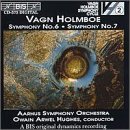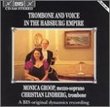| All Artists: Vagn Holmboe, Owain Arwel Hughes, Aarhus Symphony Orchestra Title: Vagn Holmboe: Symphony No. 6, Op. 43 (1947) / Symphony No. 7, in one movement, Op. 50 (1950) - Owain Arwel Hughes Members Wishing: 1 Total Copies: 0 Label: Bis Release Date: 1/4/1994 Album Type: Import Genre: Classical Styles: Historical Periods, Modern, 20th, & 21st Century, Symphonies Number of Discs: 1 SwapaCD Credits: 1 UPC: 750582508424 |
Search - Vagn Holmboe, Owain Arwel Hughes, Aarhus Symphony Orchestra :: Vagn Holmboe: Symphony No. 6, Op. 43 (1947) / Symphony No. 7, in one movement, Op. 50 (1950) - Owain Arwel Hughes
CD DetailsSimilar CDs
|
CD ReviewsVery good performances of stunning symphonies 06/24/1999 (5 out of 5 stars) "Vagn Holmboe is, to state my biases up front, among my favorite symphonists of this century. (Also one of my favorite string quartet writers, and I really, really enjoy a good deal of his other music besides...) This recording is the second in one of my favorite "projects"- BIS' recording of all Holmboe's symphonies- but I will take it on its own, and not as a symbol for the series...Symphony # 6 in two movements has this wonderful way of growing from nothing. Not that it's alone in that among symphonies, of course. Holmboe does an especially fine job of it, managing the timing of his opening movement (a slow-fast-slow structure basically, though more complicated really than that, with the fast section having internal structure of its own) superbly, and (of course) there is a lot just to .enjoy. in this somewhat lengthy movement. The concluding slow section has a violin solo. The finale is a fast movement, concluding in D, with elements that suggest a rondo (though I don't think it is one, exactly.)Symphony # 7, in one movement in several sections, is most people's preference of the two, I think (I prefer 6, but only marginally- perhaps I am merely being contrarian. *g*) A motto theme is announced at the start, and the opening movement has a good deal of energy. (Holmboe's subtle use of metamorphosis- in some ways adapting a technique older than Liszt, in some ways creating entirely new tools- has been remarked on in many places elsewhere; enough just to mention that this symphony is probably the first to use it, just as the 10th is probably the last- of the symphonies, that is- to do so. So a theme might not just reappear at the end of a piece, as the opening of the 7th does several times at its end, but might in many ways (and many changes) be the basis of many of the work's other themes and gestures, and that the .least. of it- and this without the boredom that this would cause if done by a less imaginative composer. One will .not. notice all of it on a first listen. It still adds to the piece's power, especially when noticed later.)But I digress... the end of the first section leads to an intermezzo-like Intermedio, followed by a lengthy slow section that soon seems to become faster (in a fashion). This leads to a second Intermedio, followed by a section combining functions of scherzo and finale. This gains a considerable amount of energy before a third Intermedio leads to the final Andante coda, a passage of considerable beauty and some sadness followed by a memory of the opening of the work, a dying fall of B-flat onto A, and a closing D-A chord (with an F-natural giving way to an F#.) -Eric Schissel" Superior 12/25/1998 (4 out of 5 stars) "Another magnificent gift from BIS to music lovers. Recommended without reservation. Excellent recording, too." Radical Structure, Traditional Language Christopher Forbes | Brooklyn,, NY | 02/28/2003 (5 out of 5 stars) "Holmboe is the missing link in Scandanevian music. In this country, until a few years ago, 20th century Scandanevian music started with Nielsen and Sibelius and then disappeared again until more modern internationalists like Norgard. But there has been a recent rediscovery of some wonderful composers who bridge the stylistic gap between Nielsen and Norgard and Holmboe is the chief among them. Add to that, Holmboe's great gifts as a structuralist and you have a significant composer indeed. This CD, part of BIS' ongoing series devoted to the Holmboe symphonies is a great introduction to the composer. Both symphonies were composed at the midpoint in the composer's career but point out both his adherance to tradition and his radical approach to form. The 6th symphony begins softly and seems to grow from nothing. As it unfolds over two movements motives appear and transform into new motives, creating a style based on continuous variation and transformation. This style has it's antecedents in the later Sibelius symphonies and in Nielsen's most radical work, such as the 5th symphony and the Clarinet concerto. While the musical language is resolutely tonal, this approach to composition is fascinating...like watching a kalaidescope...each new detail leads in an unexpected direction.The 7th is also a wonderful and very organic work, though more boisterious in tone. Holmboe's two symphonies on this disc are sunnier than many Nordic symphonies, more like his compatriot Nielsen. But the interest in organic development leads directly to Holmboe's own student, Norgard, who's first symphony is in the Holmboe mode, and later symphonies show the same interest in long transformative processes. The sound and performances on this disc can be considered exemplary. If you like Sibelius and Nielsen...or Vaughn Williams for that matter, you will find these symphonies a welcome addition to your library."
|


 Track Listings (9) - Disc #1
Track Listings (9) - Disc #1


